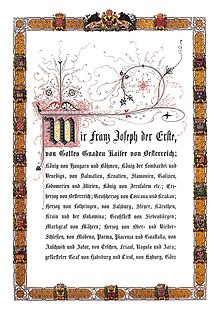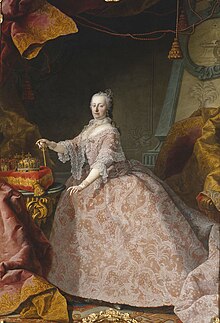
Back Velký titul rakouského císaře Czech Großer Titel des Kaisers von Österreich German Veliki naslov cara Austrije Croatian Az osztrák császárok címei Hungarian Grande Título do Imperador da Áustria Portuguese Повний титул Імператора Австрії Ukrainian
This article has multiple issues. Please help improve it or discuss these issues on the talk page. (Learn how and when to remove these messages)
|


The grand title of the emperor of Austria (German: Großer Titel des Kaisers von Österreich) was the official list of the crowns, titles, and dignities which the emperors of Austria carried from the foundation of the empire in 1804 until the end of the monarchy in 1918.
After the House of Habsburg established itself in the 11th century, it grew in power. Various domains were added to its empire in central, eastern and western Europe. The throne of the Holy Roman Empire was continuously occupied by the Habsburgs between 1438 and 1740, and again between 1745 and the dissolution of the Holy Roman Empire in 1806. The house also produced kings of Bohemia, Germany, Hungary, Croatia, Portugal, Spain, England and Ireland, as well as rulers of several Dutch and Italian principalities amongst many others.
The Austrian Empire was declared as the Holy Roman Empire dissolved itself and became a successor state. The former Holy Roman Emperor Francis II became the Emperor of Austria. In accordance with tradition and the titles that were already held, he promulgated the grand title to codify the most important monarchical titles of various countries and territories under Habsburg rule, and also of titular rulers of former possessions. With the Austro-Hungarian Compromise of 1867 the grand title was again slightly modified. Although the Austrian emperor was also the nominal head of the German Confederation, this was not included in the grand title.
The grand title was not a complete listing of all the titles held; instead it ends with an etc. There were also a middle title and a small title. The empress was also given the feminine version of the title.